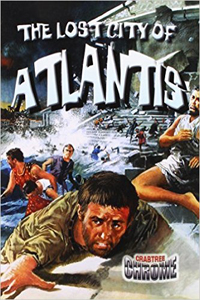| ________________
CM . . .
. Volume XXII Number 36. . . .May 20, 2016
excerpt:
Skeptics and believers will be thrilled to read The Lost City of Atlantis, one of the many books in the “Crabtree Chrome” series, because Hyde presents information which supports both sides of this mysterious three-ringed city. The book begins and ends with scientists who believe they have found Atlantis, with the majority of the 48 page book being devoted to the city’s origins, descriptions of its citizens (Poseidon, farmers, artists) and infrastructure (bathhouses, fountains, canals) and how its story may or may not have been told by philosophers over the years. Whether the city existed or not, the book brings to life a magical place which was destroyed in a mysterious way. Was it a natural disaster or angry gods that caused its demise in the ocean? And where are the remains today? Based on artifacts and unusual groupings of rocks, places that are mentioned in the book include the island of Crete, the coast of Spain, and Morocco. For those who don’t believe a city can just disappear, the author includes facts about the demise of Pompeii and Crete. The book ends with a chapter entitled “Atlantis Today” which describes how the sunken city is being kept alive today in comics, movies, and aquariums and how sonar technology may help find Atlantis, wherever it may be, under the ocean. A bibliography of books and websites is listed in the back material of the book, as well as a glossary of over twenty words that are defined in the book, and an index which includes the page numbers for the numerous photographs and paintings that appear throughout the book. The Lost City of Atlantis is educational and interesting! Highly Recommended. Tanya Boudreau is a librarian at the Cold Lake Public Library in Cold Lake, AB.
To comment
on this title or this review, send mail to cm@umanitoba.ca.
Copyright © the Manitoba Library Association. Reproduction for personal
use is permitted only if this copyright notice is maintained. Any
other reproduction is prohibited without permission.
Next Review | Table of Contents For This Issue - May 20, 2016 |
